Building Restoration Calgary

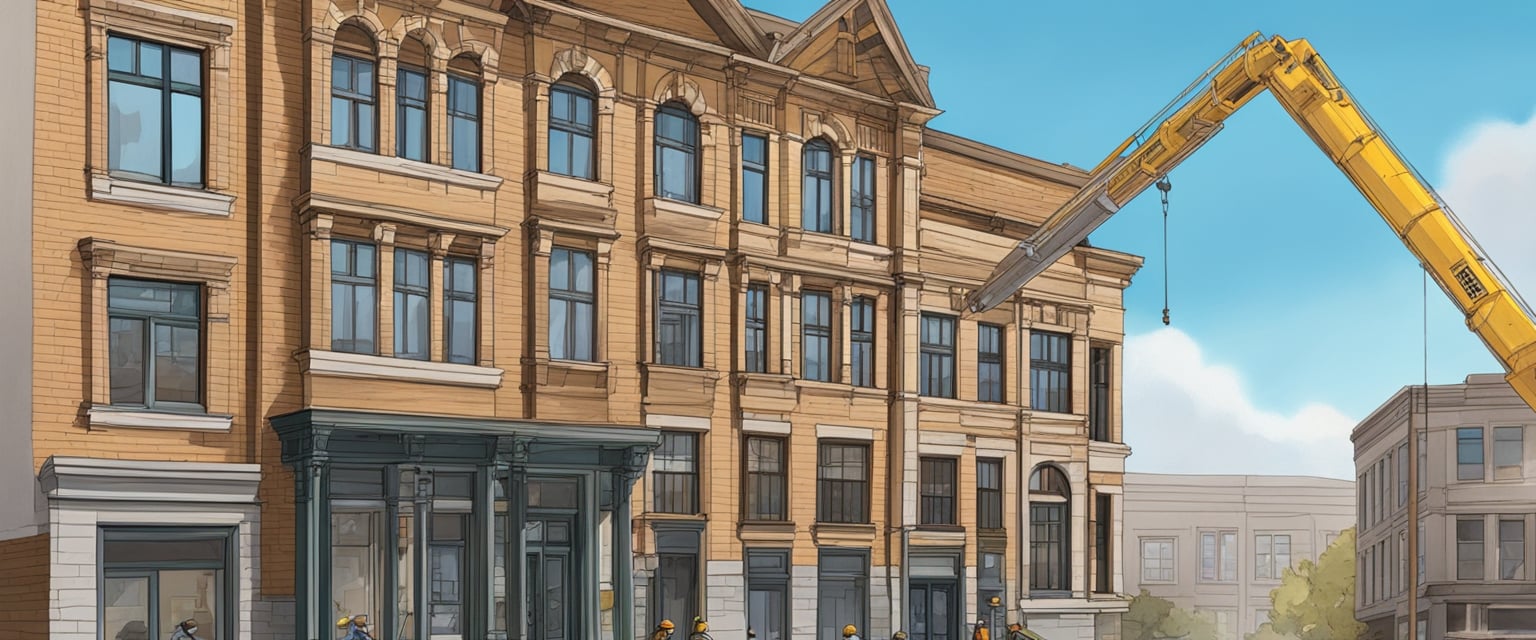
Revitalizing Heritage Structures for Modern Use
Building restoration in Calgary is essential for maintaining the beauty and safety of both residential and commercial properties. Professional restoration services can help extend the life of a building, addressing issues like structural damage, mold, and wear and tear. With a range of specialized companies available, property owners can find the right experts to meet their needs.
Understanding the various types of building restoration services is important. From emergency responses to planned renovations, these services cater to diverse challenges that property owners face. As buildings age, seeking timely restoration can prevent larger problems and protect investments.
Choosing the right restoration partner ensures quality work and a seamless process. Experienced companies in Calgary utilize skilled tradespeople and the latest techniques to restore buildings to their best condition. This commitment to excellence guarantees that properties not only look great but remain safe for occupants.
Key Takeaways
- Building restoration enhances the life and safety of properties.
- Understanding available services helps address specific restoration needs.
- Selecting a skilled restoration partner is crucial for quality outcomes.
Understanding Building Restoration
Building restoration involves the repair and renovation of structures to bring them back to their original condition. This process serves various purposes, from preserving historical architecture to addressing damages caused by natural disasters.
Categories of Building Restoration
Building restoration can be divided into several categories based on the specific needs of a project. Key categories include:
- Historical Restoration: This focuses on preserving the original features of older buildings. It aims to maintain their cultural significance. Techniques may include repairing or replacing historical windows and doors.
- Commercial Restoration: This type is tailored for businesses needing repairs. It often involves bringing a property back to its pre-loss condition following incidents like fire or water damage.
- Residential Restoration: This includes efforts to fix damage in homes caused by various factors, such as leaks or structural issues. Skilled teams evaluate the damage and provide solutions that can restore comfort and safety.
Each category requires a specific approach and expertise to ensure the building’s functionality and appearance are restored effectively.
Significance of Building Restoration in Calgary
In Calgary, building restoration plays a vital role in maintaining the community’s architectural heritage. Many older buildings contribute to the city’s character. Restoring these structures safeguards their historical value.
Restoration services are crucial when a building suffers from fire, water, or structural damage. Quick action can prevent further deterioration and help return the property to its pre-loss condition.
Local companies, like Turnkey Renovations, specialize in various restoration needs, ensuring that both commercial and residential buildings are handled by experts. This professional help is essential for preserving the integrity of Calgary’s architecture while enhancing the safety and usability of buildings for residents and businesses alike.
Types of Building Restoration Services
Building restoration services play a vital role in preserving the integrity of properties. Each type addresses specific issues that can arise from various damages.

Water Damage Restoration
Water damage can occur from leaks, floods, or burst pipes. Swift action is crucial to prevent long-term problems. Restoration experts assess the damage and develop a tailored action plan.
The process usually includes:
- Water removal: Extracting standing water using pumps and vacuums.
- Drying: Utilizing industrial fans and dehumidifiers to eliminate moisture.
- Cleaning and sanitizing: Disinfecting affected areas to prevent mold growth.
Restoration specialists often check for structural integrity after water removal. It ensures that the building remains safe for occupants. Efficient water damage restoration reduces repair costs and maintains the building’s value.
Fire Damage Restoration
Fire damage restoration involves multiple steps to recover a property after a fire incident. The process starts with an inspection to assess the extent of damage.
Key stages include:
- Smoke and soot removal: Cleaning surfaces to eliminate harmful residues.
- Structural repairs: Fixing walls, roofs, or floors damaged by flames.
- Deodorization: Removing lingering smoke odors with specialized equipment.
Timely restoration is essential. It prevents further deterioration and prepares the space for occupancy. Fire damage restoration aims not only to repair but also to bring the property back to its pre-fire condition.
Mold Remediation
Mold can develop in damp environments and pose health risks. Mold remediation focuses on identifying and eliminating mold growth effectively.
The process generally involves:
- Inspection: Identifying areas affected by mold and assessing moisture levels.
- Containment: Using barriers to prevent mold spores from spreading.
- Removal: Safely disposing of contaminated materials.
Mold remediation goes beyond just cleaning. It addresses underlying moisture issues to prevent future growth. Proper remediation restores the safety and air quality of the building, benefiting all occupants.
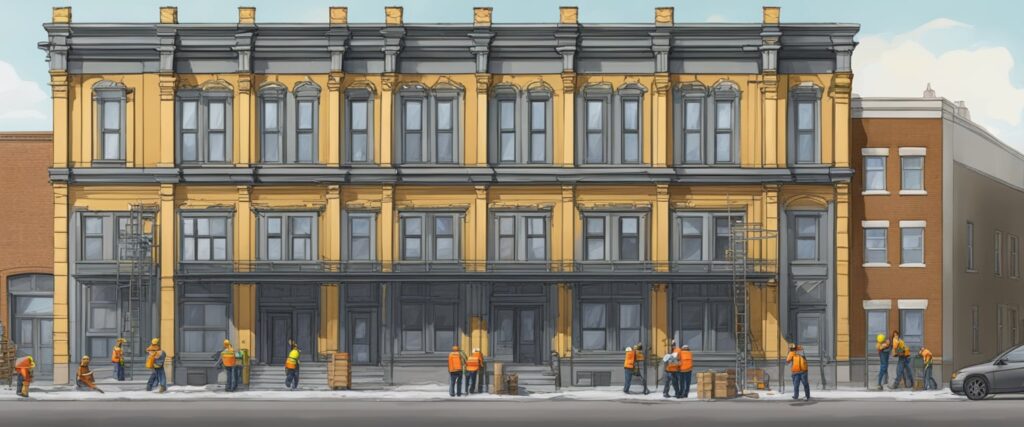
The Restoration Process
The restoration process involves several key steps to ensure that buildings return to their pre-loss condition. Each phase is crucial for achieving effective, lasting results while addressing any damage.
Assessment of Damage
The first step in restoration is a thorough assessment of the damage. This involves trained professionals examining affected areas to identify issues such as water damage, mold growth, or structural concerns.
They use specialized tools for precise evaluations. Inspectors often take notes and photographs to document findings. Understanding the extent of the damage is essential for creating an accurate restoration plan.
This step may include checking for underlying problems that are not immediately visible, like moisture in walls. After this assessment, restoration services can provide a clearer picture of the work needed to return the building to its original state.
Restoration Planning
Once the damage is assessed, a detailed restoration plan is developed. This plan outlines the specific actions required to address each type of damage identified during the assessment.
The plan may include timelines, costs, and necessary materials. Professionals work closely with clients to ensure the approach meets their needs while complying with local regulations.
Effective planning also considers potential disruptions to occupants and incorporates strategies to minimize them. A well-thought-out restoration plan is critical for successful execution, ensuring that the project stays on track and within budget.
Execution and Monitoring
After planning, the actual restoration work begins. Qualified teams carry out repairs according to the established plan. This may involve repairs to the structure, remediation of mold, or water extraction.
Throughout this phase, constant monitoring is vital. Supervisors check progress, ensuring that each stage meets quality and safety standards.
If unexpected issues arise, adjustments to the plan are made promptly. This flexibility helps maintain momentum in the restoration process. Ultimately, diligent execution and monitoring help to ensure that the property returns to its pre-loss condition efficiently and effectively.
Commercial Building Restoration
Commercial building restoration involves addressing various issues that can arise due to water damage, mold growth, and other factors. It requires specialized knowledge to ensure that the process is efficient and compliant with local building codes.
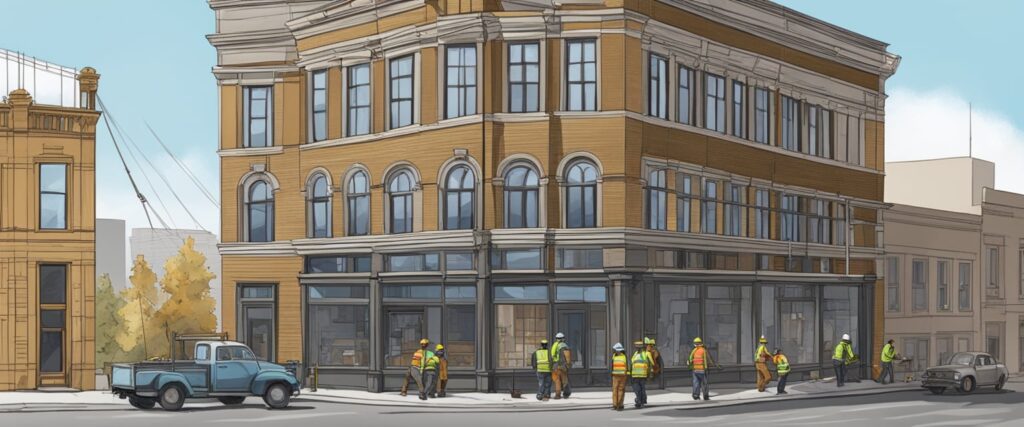
Challenges in Commercial Restoration
Restoring commercial buildings presents distinct challenges, such as tight timelines and potential disruptions to businesses. Water damage can severely impact operations, often leading to costly downtime. Quick response is essential to mitigate these risks and to prevent further mold growth, which can develop within 24 to 48 hours after water exposure.
Additionally, each commercial property may have unique structural complexities. This can include specialized materials, outdated systems, or historical significance, all of which require specific restoration techniques. Adhering to safety regulations and building codes can complicate the restoration process, demanding careful planning and execution.
Tailored Solutions for Commercial Clients
To effectively address the needs of commercial clients, restoration services often provide tailored solutions. This begins with a detailed assessment of the property to identify the extent of water damage or mold presence. Services like water damage restoration typically involve advanced techniques such as thermal imaging to detect hidden issues.
Following the assessment, restoration companies implement a targeted approach. For instance, if mold removal is necessary, they use specialized equipment and techniques to ensure complete eradication while following health guidelines.
Additionally, enhancements like upgraded materials and energy-efficient systems can be integrated during restoration. This proactive approach not only restores the building but also improves its overall value and functionality. Ultimately, these tailored solutions help commercial properties recover swiftly and effectively.
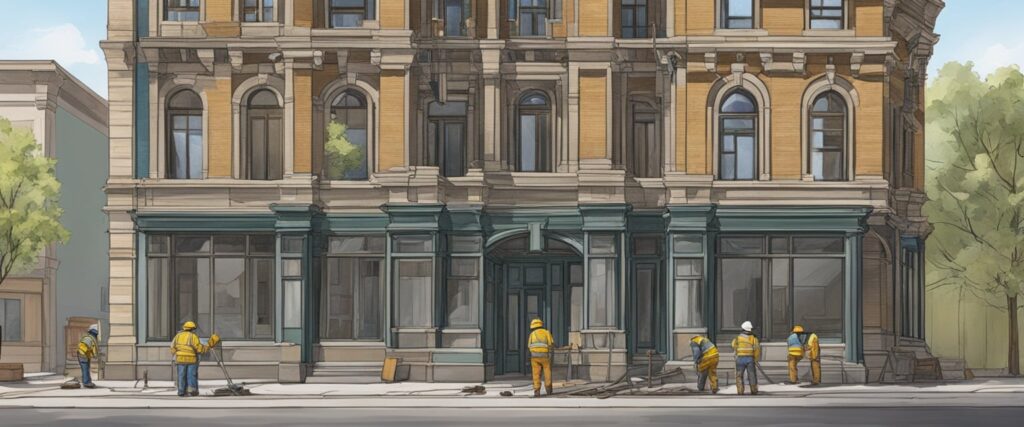
Maintaining Building Integrity
Maintaining the integrity of a building is essential for its longevity and safety. Key practices involve implementing preventative measures and understanding the benefits of long-term restoration work.
Preventative Measures
Preventative measures are essential to keep buildings in optimal condition. Regular inspections are crucial for identifying potential issues early on. This includes checking for water damage, structural cracks, and deterioration of materials.
Routine Maintenance Tasks:
- Scheduled Inspections: Conduct assessments bi-annually or annually.
- Moisture Control: Ensure proper drainage systems to prevent water accumulation.
- Sealants and Coatings: Use quality sealants to protect surfaces from weather damage.
These steps help maintain the building’s structural integrity and can save costs associated with significant repairs in the future.
Long-Term Restoration Benefits
Investing in long-term restoration provides various benefits that extend beyond aesthetics. Proper restoration improves the value and safety of the building.
Key Benefits Include:
- Increased Lifespan: Well-maintained buildings enjoy significantly longer usable lives.
- Enhanced Safety: Addressing underlying issues prevents accidents and injuries.
Furthermore, customers of restoration services often notice lower energy costs and improved comfort levels. Understanding these advantages can encourage proactive building maintenance and restoration actions.
By focusing on both preventative measures and long-term benefits, building owners can ensure their properties remain safe, functional, and valuable for years to come.
Selecting a Restoration Partner
Choosing the right restoration partner is crucial for successful recovery after damage to property. Clients should consider specific criteria to ensure they select a reliable service provider. Evaluating the skills and experience of restoration experts can significantly affect the outcome of the restoration process.
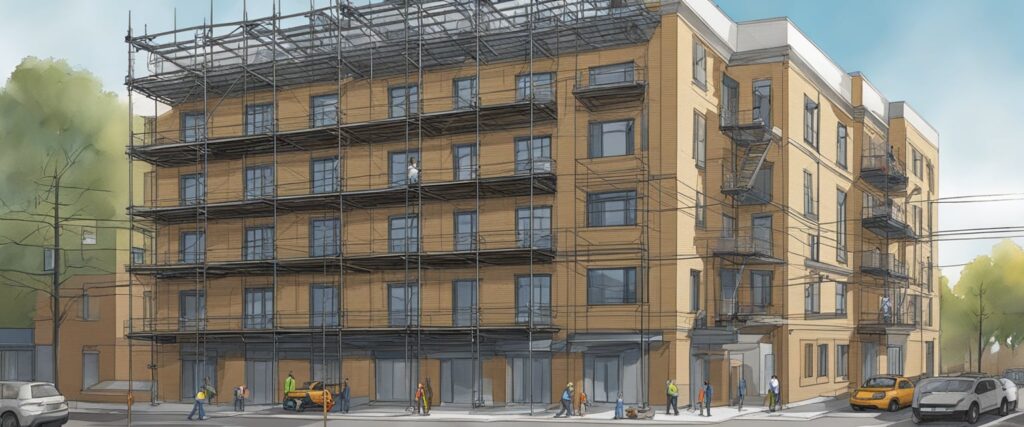
Criteria for Selection
When selecting a restoration partner, clients should focus on several key criteria. First, consider local expertise. A company familiar with Calgary’s specific conditions can offer tailored solutions.
Next, check for certifications and licenses. A reputable restoration service will have proper credentials, demonstrating their commitment to quality and excellence.
Emergency services are also important. The best companies offer 24/7 assistance, important for urgent situations.
Client testimonials provide insight into previous experiences. Look for positive reviews and success stories to gauge reliability.
Evaluating Restoration Experts
To evaluate restoration experts, start with a thorough review of their experience. Companies should have a strong track record in restoration services, including water, fire, and mold damage. It’s best to seek firms that have handled projects similar in scope and complexity.
Consider requesting a consultation. This allows clients to discuss their specific needs and evaluate the company’s approach.
Assess the technology and techniques they use. Advanced equipment indicates a commitment to excellence and effective restoration.
Lastly, ask about the process they follow. A clear and organized method shows professionalism and helps clients feel more at ease throughout the restoration.
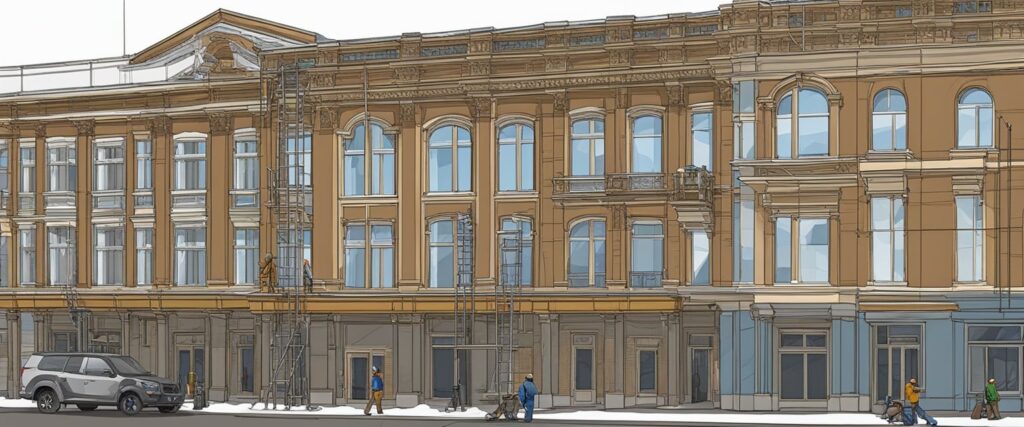
Best Practices in Building Restoration
Successful building restoration requires a combination of innovative techniques and adherence to safety standards. Focusing on these aspects ensures that projects not only meet client expectations but also uphold the integrity of the structures being restored.
Innovative Restoration Techniques
Employing cutting-edge techniques is essential in modern building restoration. One popular method is structural reinforcement, which strengthens buildings while preserving their historical charm. Restoration experts often use advanced materials, such as carbon fiber and epoxy resins, to enhance structural integrity without compromising aesthetics.
Additionally, thermal imaging is a valuable tool. This technology helps identify moisture issues in walls, roofs, and foundations early on. By catching these problems before they escalate, restoration services can prevent significant damage and high costs.
Furthermore, eco-friendly materials are gaining traction. Using sustainable resources not only benefits the environment but also appeals to clients looking for green solutions. An example includes recycled materials in construction and finishes.
Ensuring Safety and Compliance
Safety is a top priority in building restoration projects. Experts always conduct thorough site assessments to identify potential hazards. This includes checking for asbestos and mold, which can pose serious health risks if not handled properly.
Compliance with local building codes is crucial. Restoration professionals must be familiar with regulations regarding structural work, electrical systems, and plumbing. This ensures that all restoration efforts meet legal standards and are safe for occupants.
Frequent training in safety protocols is standard among skilled laborers. They must stay updated on best practices and related certifications, allowing them to deliver excellence in every project while maintaining safety for all involved.
Conclusion
Building restoration in Calgary plays a crucial role in maintaining the integrity and appearance of structures. It is an essential service, especially for older buildings that require repair.
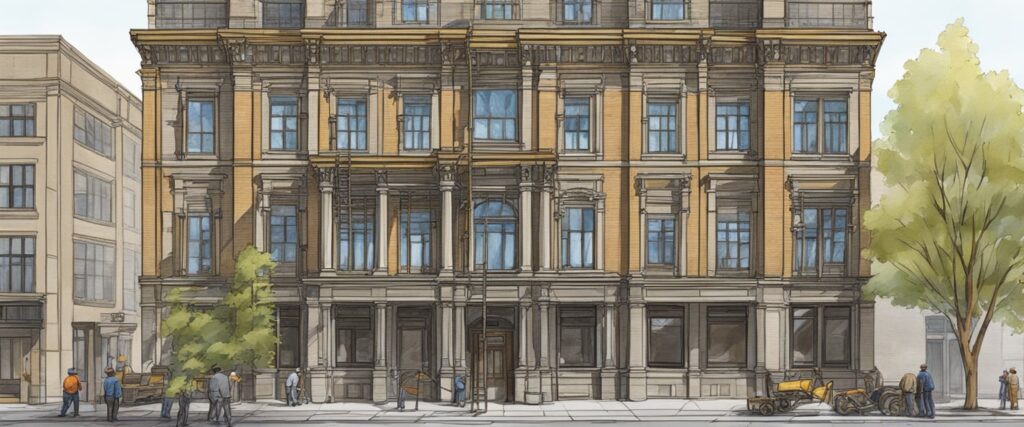
Professionals in this field assess and address various issues, such as:
- Structural Damage: Repairs to ensure safety.
- Water Damage Restoration: Fixing leaks and moisture problems.
- Historical Preservation: Maintaining the character of historic buildings.
Companies like Turnkey Renovations provide expertise in these areas. They work with building managers and owners to create effective restoration plans.
Choosing the right restoration company is vital. Quality services can extend a building’s life while enhancing its value. It is important to consider factors like reputation, experience, and customer reviews.
In Calgary, the demand for reliable restoration services continues to grow. As buildings age or face unforeseen damage, skilled contractors will remain essential for effective building restoration. Emphasizing the importance of preserving structures can lead to a more sustainable urban environment.

Frequently Asked Questions
This section addresses common questions about building restoration in Calgary. It provides clear answers regarding processes, costs, and how to choose the right service for specific needs.

The residential building restoration process typically starts with an assessment of the damage. This involves inspecting the property to determine the extent of repairs needed.
Next, the restoration team develops a detailed plan to address the issues identified. This includes securing necessary permits and coordinating with other professionals if needed.
Finally, actual restoration work begins, which may involve repairing or replacing damaged materials, structural work, and finishing touches.
To find reputable building restoration services in Calgary, one can start by seeking recommendations from friends or searching online reviews. Checking the company’s credentials and experience in the field is essential.
It is also beneficial to request quotes from multiple companies. Comparing services and prices helps in making an informed choice.
Costs for small building restoration projects can vary widely. Factors such as the type of damage, materials required, and labor costs influence the final price.
Generally, homeowners might expect to spend anywhere from a few hundred to several thousand dollars, depending on the scope of work needed.
Yes, some building restoration companies in Calgary offer free consultations. These services allow homeowners to discuss their issues and receive initial advice without any financial commitment.
It is advisable to inquire about free consultation options when contacting restoration firms to explore these opportunities.
When choosing a building restoration company, several criteria should be considered. Reputation and experience in the industry are critical factors.
Additionally, reviewing certifications and insurance coverage helps ensure the company meets necessary standards. Customer service and responsiveness can also indicate the quality of a business.
Common practices for concrete repair include crack injection, resurfacing, and patching. Crack injection involves filling cracks with epoxy or polyurethane solutions to restore structural integrity.
Resurfacing provides a new layer on top of existing concrete, improving appearance and strength. Patching is used for filling larger voids or damages to ensure a durable surface.

